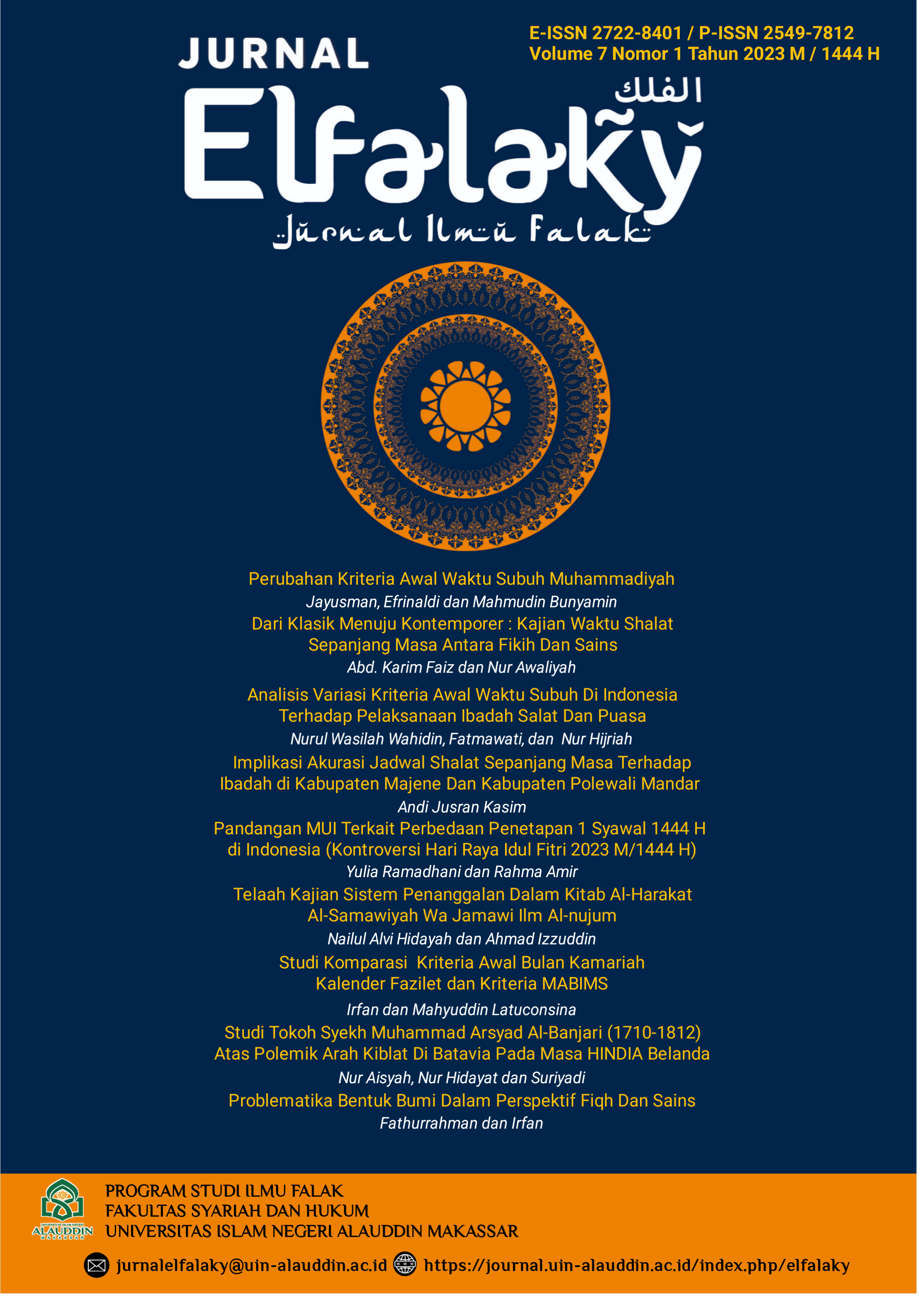The TELAAH KAJIAN SISTEM PENANGGALAN DALAM KITAB AL-HARAKAT AL-SAMAWIYAH WA JAMAWI ILM AL-NUJUM
Abstract
Al-Farghani is the author of the book al-harakat al-samawiyah wa jawami ilm al-nujum which contains a summary of astronomy’s sciences. Until now, the book is still being translated into two languages, namely Latin and Arabic. Due to the lack of literature in both English and Indonesian, the author is interested in examining the contents of the book within the scope of Islamic astronomy studies, especially in the first chapter of the book which discusses the calendar system. This study aims to find out how is the study of the calendar system in the book al-harakat al-samawiyah wa jawami ilm al-nujum and how its correlates with modern astronomical knowledge. Library research method with descriptive approach are used in this research. The results of this study indicate that the calendar system contained in the book can be classified into 5 and addopted to 2 systems, namely the Hijri calendar with the lunar system, and Syriac, Roman, Persian and Coptic with a solar system. Each calendar system has a variation in the number of the days and month names. Some of the numbers of days can be correlated with astronomical calculations and some of them are based on culture.
References
Abdukhalimov, B. “Ahmad Al-Farghani and His Compendium of Astronomy.” Journal of Islamic Studies, 1999.
Abrahamson, Ben, and Joseph Katz. “The Islamic Jewish Calendar.” Studies in Hostory and Jurisprudence, 2007, 1–20.
Akrami, Musa. “The Development of Iranian Calendar: Historical and Astronomical Foundations,” 2011, 1–20. http://arxiv.org/abs/1111.4926.
Al-Azizi, Abdul Syukur. Untold Islamic History. Edited by Yanuar Arifin. Yogyakarta: LAKSANA, 2018.
Cohen, Charles L., and Silvio A. Bedini. “The Christopher Columbus Encyclopedia.” Sixteenth Century Journal, 1993. https://doi.org/10.2307/2542130.
Daneshgar, Majid. “Elementa Astronomica by Al-Farghani/Alfraganus (Chapter 1),” 2018, 7.
Fuscha, Fika Afhamul. “Verification of the Hisab Ephemeris System Against the Hijri Calendar Leap Year Pattern with Criteria Imkan Al-Rukyah MABIMS (Case Study in Kudus District.” Al-Hilal: Journal of Islamic Astronomy, 2021. https://doi.org/10.21580/al-hilal.2021.3.1.7733.
Mousavi, Razieh S., and Jannis Niehoff Panagiotidis. “Harmonization of Calendars in The Early Islamic World as Reflected in Al-Farghani’s Elements of Astronomy.” Antigüedad y Cristianismo, 2021. https://doi.org/10.6018/ayc.471611.
Parise, Frank. The Book of Calendars. New York: Facts On File, Inc., 1982. https://archive.org/details/bookofcalendars0000unse_y2i4/page/n10/mode/1up?view=theater.
Rashed, M.G., M.G. Moklof, and Alaa E. Hamza. “Investigation the Arithmetical or Tabular Islamic Calendar.” NRIAG Journal of Astronomy and Geophysics, 2018. https://doi.org/10.1016/j.nrjag.2017.12.005.
Rofiuddin, Ahmad Adib. “Penentuan Hari Dalam Sistem Kalender Hijriah.” Al-Ahkam, 2016. https://doi.org/10.21580/ahkam.2016.26.1.878.
Slamet Hambali. Almanak Sepanjang Masa. Edited by Abu Rokhmad. Semarang: Program Pasca Sarjana IAIN Walisongo Semarang, 2011.
Sopwan, Novi, Moedji Raharto, Budi Dermawan, and Dhani Herdiwijaya. “The Gradual Changes of Synodical Period of The Moon Phase,” 2008, 6.
Taqizadeh, S. H. “The Old Iranian Calendars.” Bulletin of the School of Oriental and African Studies, 1952. https://doi.org/10.1017/S0041977X00088558.
The Biographical Encyclopedia of Astronomers. The Biographical Encyclopedia of Astronomers, 2007. https://doi.org/10.1007/978-0-387-30400-7.
Unat, Yavuz. “Alfraganus and the Elements of Astronomy.” Foundation for Science Technology and Civilisation, 2007, 1–15.





